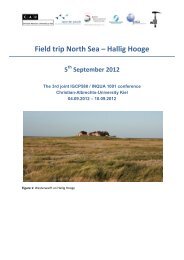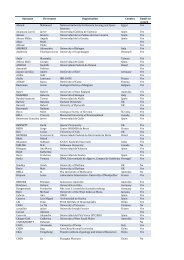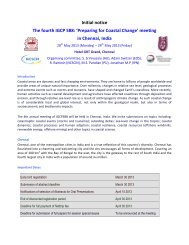Conference program and abstracts - Coastal-Change.Org
Conference program and abstracts - Coastal-Change.Org
Conference program and abstracts - Coastal-Change.Org
You also want an ePaper? Increase the reach of your titles
YUMPU automatically turns print PDFs into web optimized ePapers that Google loves.
Investigating inter--‐annual <strong>and</strong> multi-‐decadal signals in<br />
tide gauge records from Vietnam; Implications for sea<br />
level <strong>and</strong> coastal hazard studies<br />
Dat T. Pham 1 , Adam D. Switzer 1,2 , Aron J. Meltzner 1,2<br />
1<br />
Division of Earth Sciences, Nanyang Technological University,<br />
Singapore.<br />
2<br />
Earth Observatory of Singapore, Singapore, Singapore.<br />
ABSTRACT<br />
<strong>Coastal</strong> flooding commonly causes property <strong>and</strong> economic damage<br />
<strong>and</strong> the loss of lives in low--‐lying <strong>and</strong> densely populated coastal<br />
areas. Tidal variations <strong>and</strong> sea level variability are two of the primary<br />
local factors that can enhance the risk of coastal flooding in<br />
decades to come. On inter--‐annual time scales, tidal variations are<br />
affected by two important cycles, name--‐ ly, the nodal 18.6--‐year lunar<br />
nodal cycle <strong>and</strong> the 8.85--‐year cycle of lunar perigee. Investigating<br />
these tidal modulations would allows potentially predicting periods<br />
when enhanced risk of coastal flooding is likely.<br />
In this study, we focused on high tide levels <strong>and</strong> extreme sea levels<br />
which have not been extensively studied. We investigated sea level<br />
data from three tide gauges distributed evenly along the Vietnam<br />
coastline to define: 1) the inter--‐annual modulation signals (targeting<br />
the nodal <strong>and</strong> perigee cycles) on high tide levels <strong>and</strong> 2) the long-<br />
-‐term variations of extreme sea levels. We applied the percentile<br />
time--‐series analysis method to figure out tidal modulations <strong>and</strong> least<br />
squared equations to study the long--‐term rate of sea level change.<br />
The results revealed that the nodal cycle predominates at Hon Dau,<br />
which has a diurnal tide regime. In contrast the mixed tide regions of<br />
Son Tra <strong>and</strong> Vung Tau showed no effects of either cycles. Regarding<br />
long--‐term rates of mean sea level changes at all three stations, the re--‐<br />
sults are fairly consistent with previous studies. Extreme levels at Hon<br />
Dau show higher rates than the rate of mean sea level whereas at<br />
Vung Tau, the rates for all levels are similar. The complicated variations<br />
of extreme levels are found at Son Tra <strong>and</strong> it suggests further<br />
investigation should be carried out.<br />
The Fourth IGCP 588: PREPARING FOR COASTAL CHANGE 33





